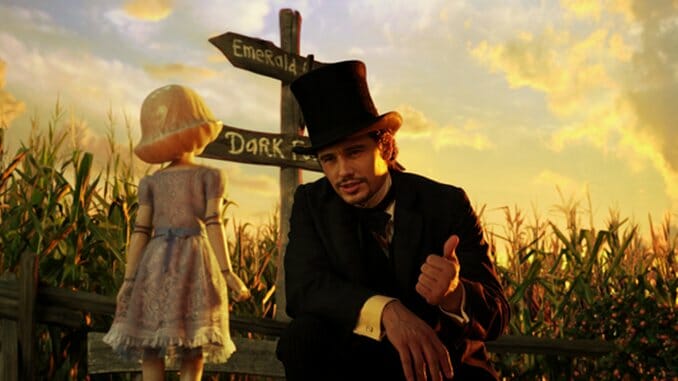
Published in 1900, L. Frank Baum’s original The Wonderful Wizard of Oz is a peculiar piece of myth-making. For one thing, it neatly sidesteps the overt moralizing of the more traditional fairy tales of Grimm, Goose et al. Though plenty strange and wonderful in cast and occurrences, Baum’s tale falls a full rabbit hole shy of the rampant whimsy and strangeness of Lewis Carroll’s Alice’s Adventures in Wonderland. Yet, neither is it the type of cumbersome (and/or terrifying) allegory that would mark future works involving talking animals. (Of course, by 1945’s Animal Farm, the world’s psyche had been given a lot more horror to digest.)
And then there’s the catalyst of 1939’s classic film treatment, The Wizard of Oz. Would Baum’s initially beloved books have cleaved to the popular imagination without the silver screen assistance of Garland, Bolger, Lahr, Haley and company? It’s hard to say. Would we have Sam Raimi’s latest film? Definitely not.
A prequel to the 1939 groundbreaker, Oz the Great and Powerful tells the story of how a carnival con man (James Franco) arrives in Oz, meets a monkey, a china doll and some witches, and becomes the Wizard. From the get-go, Raimi’s film is both tribute to and evocation of its predecessor. After a black-and-white opening that quickly gives way to a tornado-powered exit, pretty much everything encountered in Oz that was seen in the original film—munchkins, a yellow brick road, a green witch astride a broomstick in desperate need of an oil change—are faithful recreations of the original vision.
More often than not, this isn’t a bad thing. Much in the same manner that Raimi’s first two Spider-Man movies successfully channeled the vigor and élan of the original comics even while presenting them for modern tastes to devour, his Oz is replete with the spirit and vision of the original film. (For those hoping for more subversive themes, such as imagined in Gregory Maguire’s Wicked, no dice.)
That’s not to say the production design relies solely on a movie 74 years its senior. Much as Baum’s original book drew its inspiration from myriad, disparate sources without overly relying on any of them, Raimi’s film draws on plenty of non-Ozian imagery to build its world. There are the magnificent vistas that evoke Maxfield Parrish, an Emerald City that occasionally looks like Fritz Lang’s Metropolis and the Winkies, who look like nothing less than an army of Gerard Depardieus (post Green Card, poor things).
The cast does a first-rate job. Franco, who in the past few years has drifted a bit toward “Joaquin Phoenix Land” in terms of real world eccentricity, turns in a pleasantly nuanced performance in a role that doesn’t really demand one.
As Glinda, Michelle Williams delivers the most understated performance of the entire film—which is saying something when you wield a magic wand and travel by bubble. At times, it feels like Williams is dipping into that “Marilyn Monroe mystique” she so deftly conjured in My Week with Marilyn. Whatever her technique, the result guarantees that a character who is supposed to be immensely appealing is very much so.
Rachel Weisz and Mila Kunis bring a similar level of intensity—and when called for, scenery-chewing—to their witchy roles. (For fun, pretend Weisz’s Evanora is the long-lost sister of Emperor Palpatine.)
As is increasingly the case in a post-Gollum world, the other actors of note in Oz the Great and Powerful are CGI creations. Finley the flying bellhop monkey (voiced by Zach Braff), while exquisitely rendered, settles cleanly into its supporting role. But with the China Girl (voiced by Joey King), Raimi’s team has created the one character who can compete with Williams in terms of sheer appeal. (Surprisingly, China Girl’s physical interactions with the live actors are often slightly off, especially when being picked up or held by a character—where’s Andy Serkis when you need him?)
Taken all together, Raimi manages to recreate to the extent possible what it must have felt like for viewers who first experienced that transition from black-and-white to glorious technicolor. His Oz is super-saturated with color—it’s the stuff that Skittles commercials are made of. (It makes the Sugar Rush video game in Wreck It Ralph seem a wee bit drab in comparison.) More impressively, Oz the Great and Powerful may well be the first movie since Avatar to fully exploit 3D’s potential as a “wonder delivery device” for the entire length of the movie.
Oz the Great and Powerful is by no means a perfect film. But for connoisseurs of well-crafted cinematic confection, for many fans of the original Wizard of Oz, and for parents who wish to introduce their (nightmare-resistant) children to the wonder of L. Frank Baum’s world, it’s a great and powerful opportunity, indeed.
Director: Sam Raimi
Writer: Mitchell Kapner & David Lindsay-Abaire (screenplay); L. Frank Baum (novel)
Starring: James Franco, Mila Kunis, Rachel Weisz, Michelle Williams, Zach Braff, Bill Cobbs, Joey King
Release Date: Mar. 8, 2013
Michael Burgin reviews movies from time to time.